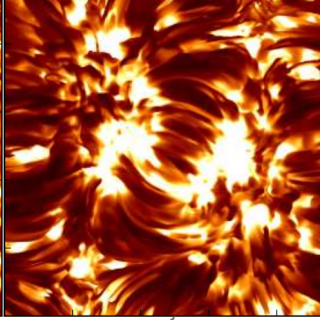Bibcode
Felipe, T.; Collados, M.; Khomenko, E.; Rajaguru, S. P.; Franz, M.; Kuckein, C.; Asensio Ramos, A.
Bibliographical reference
Astronomy and Astrophysics, Volume 608, id.A97, 12 pp.
Advertised on:
12
2017
Journal
Citations
12
Refereed citations
11
Description
Aims: We investigate the properties of a sunspot light bridge,
focusing on the changes produced by the impact of a plasma blob ejected
from a C-class flare. Methods: We observed a sunspot in active
region NOAA 12544 using spectropolarimetric raster maps of the four Fe I
lines around 15 655 Å with the GREGOR Infrared Spectrograph,
narrow-band intensity images sampling the Fe I 6173 Å line with
the GREGOR Fabry-Pérot Interferometer, and intensity broad-band
images in G-band and Ca II H-band with the High-resolution Fast Imager.
All these instruments are located at the GREGOR telescope at the
Observatorio del Teide, Tenerife, Spain. The data cover the time before,
during, and after the flare event. The analysis is complemented with
Atmospheric Imaging Assembly and Helioseismic and Magnetic Imager data
from the Solar Dynamics Observatory. The physical parameters of the
atmosphere at differents heights were inferred using spectral-line
inversion techniques. Results: We identify photospheric and
chromospheric brightenings, heating events, and changes in the Stokes
profiles associated with the flare eruption and the subsequent arrival
of the plasma blob to the light bridge, after traveling along an active
region loop. Conclusions: The measurements suggest that these
phenomena are the result of reconnection events driven by the
interaction of the plasma blob with the magnetic field topology of the
light bridge.
Movies attached to Figs. 1 and 3 are available at http://www.aanda.org
Related projects

Solar and Stellar Magnetism
Magnetic fields are at the base of star formation and stellar structure and evolution. When stars are born, magnetic fields brake the rotation during the collapse of the mollecular cloud. In the end of the life of a star, magnetic fields can play a key role in the form of the strong winds that lead to the last stages of stellar evolution. During
Tobías
Felipe García

Magnetism, Polarization and Radiative Transfer in Astrophysics
Magnetic fields pervade all astrophysical plasmas and govern most of the variability in the Universe at intermediate time scales. They are present in stars across the whole Hertzsprung-Russell diagram, in galaxies, and even perhaps in the intergalactic medium. Polarized light provides the most reliable source of information at our disposal for the
Ernest
Alsina Ballester